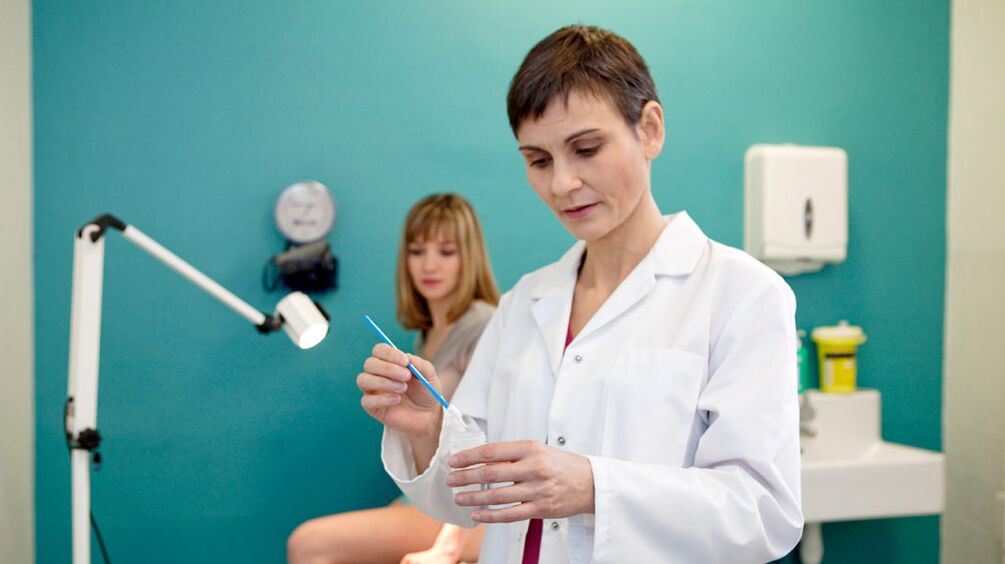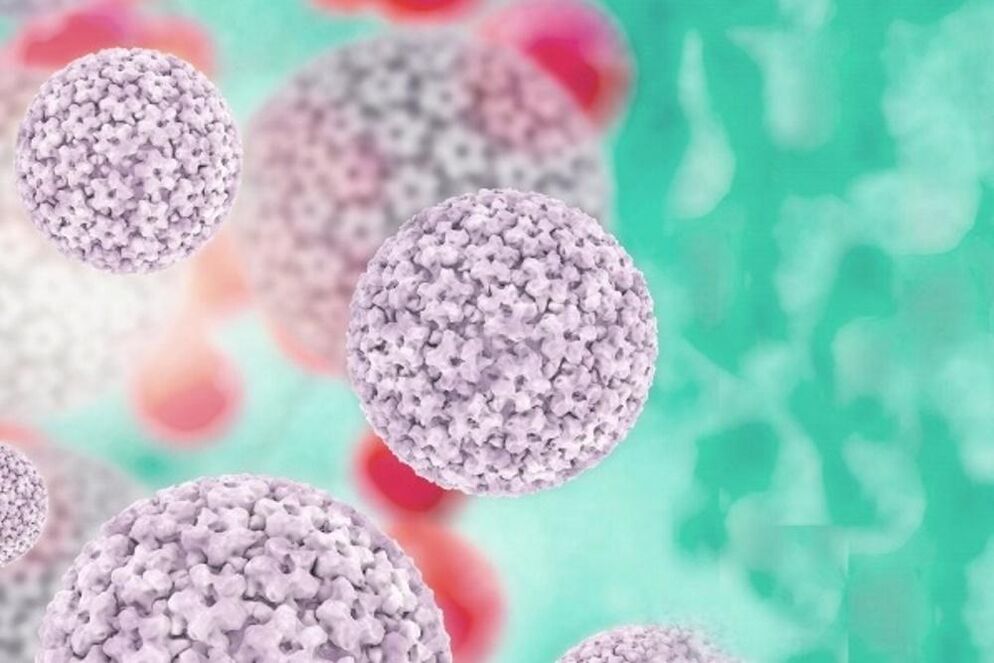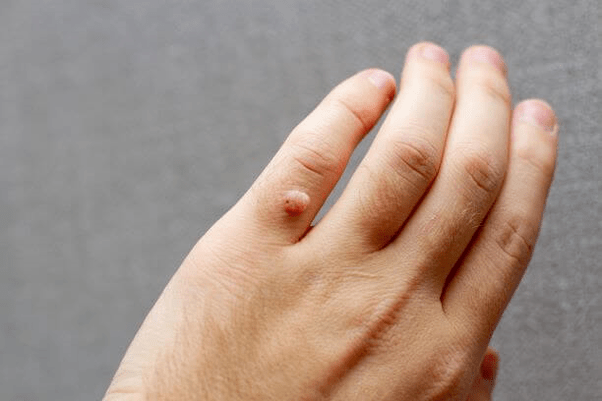
Human papillomavirus (HPV) affects epithelial cells and has a particle diameter of 55 nm. A feature is the proliferation of the skin epithelium, as well as mucous membranes. At the initial stage, the pathogen usually affects the basal cells of the epithelium, penetrating into them through microtrauma. Localized papillomas usually occur on the skin of the neck, armpits, groin and genitals (most commonly), oral mucosa, and nasopharynx.
This virus can be asymptomatic for many years. To detect HPV, electron microscopic or molecular hybridized methods are used.
Types of human papillomavirus
In humans, HPV is distinguished, which affects the mucous membranes and skin. Among the large number of papillomaviruses, there are species with low and high oncogenic risk. It has been proven that oncogenic properties are associated with the ability to integrate DNA into the genome of human cells.
The virus is activated in 10-20% of cases. Depending on its type, this can lead to benign or malignant lesions. Some HPVs are not oncogenic. They lead to the appearance of warts and genital warts. The most common are HPV 6 and 11.
HPV oncogenes are those that have a high risk of developing cancerous lesions, especially on the cervix or anus. For the skin, HPV 16 and 18 are more common, as well as HPV 5 and 8, which can lead to skin cancer. The most well-known form of HPV-induced cancer is cervical cancer. But men can also contract the papilloma virus, which in worst cases causes penis or anal cancer.
Often women are faced with HPV 16 - this is a form in which introsomal parasitism is observed, that is, outside the cell chromosome (benign). HPV 18 is characterized by a high risk of developing oncology - first, benign tumors are formed, which after a while degenerate into cancer. Virions in this case are tiny (up to 30 nm).
Various types of HPV infections lead to:
- neoplasms of the cervix;
- invasive or pre-invasive oncology;
- genital warts of the urinary tract and genitals.
The ingestion of the pathogen into the body does not always lead to disease. It all depends on the predisposing factors: increased sexual activity, vitamin deficiency, pregnancy, hypothermia, endometriosis, smoking, alcohol abuse, etc. It should be noted that a viral infection can occur even in an organism with a good immune system.
Features of infection

Human papillomavirus is highly contagious. It is usually transmitted through direct contact, skin to skin or mucous membrane to mucous membrane, with an infected person. In genital infections, this most often occurs during vaginal or oral sex. A large number of sex partners or other STIs (sexually transmitted infections) increase the risk. Indirect transmission through objects, contaminated clothing or bedding is also possible, but rarely occurs.
In 7% of cases, mother-to-child transmission of the virus can occur during childbirth when the infection is active. The risk increases to 40% if you are infected with HPV 16 or 18.

Penetrating into the epithelium, violating the integrity, papillomavirus infection promotes the growth of the lower layer of epithelial cells in the form of warts or warts. This form of the disease is contagious and spreads quickly to others. As a rule, warts and condylomas do not cause metastases and often disappear spontaneously.
HPV symptoms
The incubation period lasts up to 9 months (average 3 months). HPV can be present in the body without obvious symptoms. The virus can go undetected for months or years. Even at this stage, it is contagious.
Skin warts usually occur in clusters and increase with scratching. The two most common forms of papilloma are either grayish, hard, raised with a broken surface (common wart), or flat and reddish (flat wart). Spiky warts are found on the soles of the feet or on the heels, grow inward and are therefore often painful.
The causative agents of genital warts occur on moist and warm parts of the body, therefore they are localized in the folds and on the mucous membranes. They can cause symptoms such as itching or burning. The incubation period, that is, the time between infection and the onset of symptoms, in genital warts ranges from 3 weeks to 8 months.
There are several forms of genital warts caused by different pathogens:
- Genital warts. Pale or reddish nodules that often stand in clusters and occur on the labia, vagina, penis, urethra, anal canal, and rectum. They are highly contagious.
- Flat warts. They appear as flat knots and are found mainly on the female genital organs. They increase the risk of developing cancer.
- Giant warts (Buschke-Levenshtein tumors). They grow into huge formations, destroying the surrounding tissues. In rare cases, they can degenerate and lead to squamous cell carcinoma.

Infection of the mucous membranes in the upper respiratory tract is also possible. The conjunctiva of the eyes may be affected, resulting in pink stem growths. It is more difficult to detect an asymptomatic course, which the doctor can only see with the help of aids, such as acetic acid (which causes discoloration of the warts) or a microscope.
In addition, the virus can also take up residence in cells without any tissue changes. Then they talk about a latent infection, that is, the presence of pathogens, but without symptoms. After infection, this phase can last from several weeks to several months.
Possible consequences
When infected, viruses penetrate into the cells of the integumentary tissue of the skin and mucous membrane, settle in the nuclei of cell structures and multiply there. Usually, such HPV infections go unnoticed and heal on their own without consequences, since the immune system successfully fights the pathogen.
However, some of the HPV types create skin changes, i. e. growths. Possible forms include genital warts or warts and papillomas, which can affect, for example, the face, hands or feet.
The tissue changes caused are mostly benign, but can also degenerate and lead to cancer. For example, cancer can occur decades after HPV infection. Cancer of the external female genital organs (cancer of the vulva and vagina), anal cancer, cancer of the penis, and cancer of the mouth and throat (tumors of the head and neck) are also possible.
Establishing diagnosis

A test for HPV infection is carried out in women as part of preventive visits to the gynecologist. During a gynecological examination, a swab is taken from the lining of the cervix, this is called a Papanicolaou test (cytological examination). The resulting material is examined for tissue changes to determine precancerous conditions.
Alternatively, an HPV test can be done, in which cell material from a mucosal swab or tissue sample is tested in a laboratory for certain viruses. However, this allows to prove only the infection of the affected area, but not to make any statements about whether the tissue changes have occurred. Thus, an HPV test makes sense, especially when combined with a Pap test, and can help detect cancer precursors at an early stage.
If the test is positive, this is not yet a cause for concern, as infection does not always lead to cancer. Regular examination is recommended to detect tissue changes at an early stage. Conversely, a negative test result does not allow us to assert whether there was an infection in the past that the body successfully fought with.
For men, there is no prophylactic examination in which the test would be carried out regularly. If there is a corresponding cancer, examination of the tumor can determine whether HPV infection is at the root of the cancer.
Specialized DNA techniques are also used in laboratory diagnostics, such as real-time PCR. Anogenital warts caused by HPV types 6 and 11 are easily detected during a pelvic exam.
How to cure the human papillomavirus

In most cases, the disease does not require treatment because it goes away on its own and then viruses are no longer detected. However, if this is not the case, the infection can last longer and persist for months or years.
To date, there are no methods of systemic impact on this virus, due to which it would be possible to completely destroy it. However, treating the resulting warts reduces the number of viruses, so in many cases the immune system can fight off other viruses and thus get rid of them. In some cases, pathogens survive and can cause symptoms over and over again.
Therapeutic tactics depend on the type of HPV and the associated picture of the disease:
- Plantar and genital warts can be treated with topical salicylic acid formulations.
- Cryotherapy is also a method often used for HPV. In this case, the wart is burned with cold, using liquid nitrogen.
- Lasers or electrocautery are equally applicable methods.
Since the frequency of relapses is quite high, it is advisable to regularly check yourself and use condoms even several months after the disappearance of the lesions, so as not to infect the sexual partner.
For HPV cancers, treatment is much more difficult. In cervical cancer, it is often advisable to remove the uterus, respectively, the upper part of the vagina and ovaries. This can be supplemented with radiation therapy to rule out the likelihood of relapses. Other cancers caused by HPV are most often treated with targeted therapy, such as radiation or chemotherapy.
It should be remembered that the operation is not a cardinal solution, but only solves a cosmetic problem, since after removal the virus is able to remain in the surrounding tissues and warts may appear again.
Prevention of infection

There are two vaccinations: bivalent HPV 16 and 18 and quadrivalent HPV 6, 11, 16 and 18. Vaccination is recommended for all young girls aged 14 and over.
Vaccination does not protect against all types of HPV. Therefore, all women between the ages of 25 and 65, even if they are vaccinated, are advised to have regular smear examinations.
Timely detection and complete removal of genital warts reduces the risk of disease. The effectiveness of using condoms to prevent transmission of infection can significantly reduce the risk of developing this condition. The most promising method for the prevention and treatment of the initial stages of the disease caused by this infection is a specific multivalent vaccine.













































































